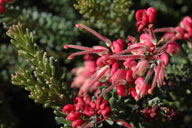

 |
Australian National Botanic Gardens |
 |
A weekly news sheet prepared by a Gardens' volunteer.
Numbers in square brackets [ ] refer to garden bed Sections.
Plants in flower are in bold type.
24 April 2009
 |
Grevillea lanigera - click for larger image |
This week’s walk is beside the daisies of Section 300, and then the path through the Western Mallee beds, which showcase the mallee flora from western South Australia and Western Australia.
Go up the hill beyond the Eucalyptus Lawn, with the site of the old Nursery on your right. On your left are several low shrubs of Marble Daisy Bush, Olearia astroloba [Section 300] with mauve daisy flowers and grey wavy leaves. This rare species occurs naturally only in a very small area in East Gippsland. A few metres on are two prostrate plants of Woolly Grevillea, Grevillea lanigera [Section 300], with reddish pink spider flowers. Behind the grevilleas are several tall shrubs, Sticky Daisy Bush Olearia elliptica [Section 300], with many white daisy flowers. Across the road on your right is a tall shrub covered in small yellow star flowers, Rulingia cuneata [Section 100b]. Continuing up the hill, on your left are mats of Brachyscome ‘Break o’ Day’ [Section 300], with mauve daisy flowers. Growing up through it is the endangered Button Wrinklewort Rutidosis leptorrynchoides, with yellow buttons on long stems. On the corner of the track with the Black Mountain Tower sign, on your right, is a low straggly shrub of Eremophila warnesii [Section 100b], with broad grey hairy leaves and large tubular purple flowers.
Turn right at the sign and then immediately right again. On your right is Hutt River Poison Gastrolobium propinquum [Section 100b], a low shrub with spikes of yellow and red pea flowers. On your left and several metres in is a tall shrub, Grevillea dielsiana [Section 100a], with finely divided leaves and weeping trusses of orange flowers. Opposite this, on your right, are two small shrubs, Shrub Violet Hybanthus floribundus [Section 100b], with masses of small white flowers. A little farther on, on the right is a small low shrub with many small bright pink flowers with long stamens. This is Hypocalymma sp. [Section 100b]. Look back at the Cup Gum Eucalyptus cosmophylla [Section 100a] above your head. It has groups of large cream flowers. Shortly, on your right, is Ravensthorpe Bottlebrush Beaufortia orbifolia [Section 100b] a small shrub with tiny round leaves and red brushes. A bit farther on, on the right is Eremophila densifolia subsp. pubiflora [Section 100b], a low wide shrub with purple bell flowers. Next to it is Thryptomene denticulata, with small pink flowers.
 |
Hakea cycloptera - click for larger image |
At the turn in the path, on the right are two tall shrubs of Grevillea ‘Sid Reynolds’ [Section 100b], with showy pink pin cushions. Going uphill again, on the left are two shrubs of Banksia epica [Section 100a], with broad toothed leaves and large yellow flower heads. A little farther on, on the right, is a straggly Winged Wattle Acacia alata [Section 100c], with winged stems and white wattle flowers. It is growing through Elm-Seed Hakea Hakea cycloptera, a large shrub with cylindrical leaves with a sharp point, and lots of pinky white spider flowers. On your left is a small shrub of Oak-leaved Dryandra Dryandra quercifolia [Section 100a], with large round flower heads, brown on the outside and green in the middle.
Betty Wood